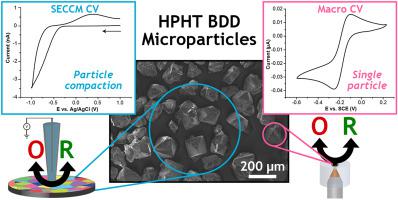Our official English website, www.x-mol.net, welcomes your feedback! (Note: you will need to create a separate account there.)
High Pressure High Temperature Synthesis of Highly Boron Doped Diamond Microparticles and Porous Electrodes for Electrochemical Applications
Carbon ( IF 10.9 ) Pub Date : 2021-01-01 , DOI: 10.1016/j.carbon.2020.09.038 Georgia F. Wood , Carmen E. Zvoriste-Walters , Mark G. Munday , Mark E. Newton , Viacheslav Shkirskiy , Patrick R. Unwin , Julie V. Macpherson
Carbon ( IF 10.9 ) Pub Date : 2021-01-01 , DOI: 10.1016/j.carbon.2020.09.038 Georgia F. Wood , Carmen E. Zvoriste-Walters , Mark G. Munday , Mark E. Newton , Viacheslav Shkirskiy , Patrick R. Unwin , Julie V. Macpherson

|
Abstract High pressure high temperature (HPHT) synthesis of crystallographically well-defined boron doped diamond (BDD) microparticles, suitable for electrochemical applications and using the lowest P and T (5.5 GPa and 1200 °C) growth conditions to date, is reported. This is aided through the use of a metal (Fe–Ni) carbide forming catalyst and an aluminum diboride (AlB2) boron source. The latter also acts as a nitrogen sequester, to reduce boron-nitrogen charge compensation effects. Raman microscopy and electrochemical measurements on individual microparticles reveal they are doped to metal-like levels, contain negligible sp2 bonded carbon and display a large aqueous solvent window. A HPHT compaction process is used to create macroscopic porous electrodes from the BDD microparticles. Voltammetric analysis of the one-electron reduction of Ru(NH3)63+ is used to identify the fundamental electrochemical response of the porous material, revealing large capacitive and resistive components to the current-voltage curves, originating from solution trapped within the pores. Scanning electrochemical cell microscopy is employed to map the local electrochemical activity and porosity at the micron scale. Such electrodes are of interest for applications which require the electrochemical and mechanical robustness properties of BDD, e.g. when operating under high applied potentials/currents, but with the additional benefits of a large, electrochemically accessible, surface area.
中文翻译:

用于电化学应用的高硼掺杂金刚石微粒和多孔电极的高压高温合成
摘要 据报道,高压高温 (HPHT) 合成晶体学定义明确的掺硼金刚石 (BDD) 微粒,适用于电化学应用并使用迄今为止最低的 P 和 T (5.5 GPa 和 1200 °C) 生长条件。这是通过使用金属 (Fe-Ni) 碳化物形成催化剂和二硼化铝 (AlB2) 硼源来辅助的。后者还充当氮螯合剂,以减少硼-氮电荷补偿效应。对单个微粒的拉曼显微镜和电化学测量显示它们掺杂到类似金属的水平,包含可忽略不计的 sp2 键合碳并显示出大的水性溶剂窗口。HPHT 压实过程用于从 BDD 微粒创建宏观多孔电极。Ru(NH3)63+ 的单电子还原伏安分析用于识别多孔材料的基本电化学响应,揭示电流-电压曲线的大电容和电阻分量,源自被困在孔隙内的溶液。扫描电化学电池显微镜用于在微米尺度上绘制局部电化学活性和孔隙率。这种电极对于需要 BDD 的电化学和机械稳健性特性的应用很感兴趣,例如当在高外加电位/电流下运行时,但具有大的、电化学可及的表面积的额外好处。揭示了电流-电压曲线的大电容和电阻分量,源自被困在孔内的溶液。扫描电化学电池显微镜用于在微米尺度上绘制局部电化学活性和孔隙率。这种电极对于需要 BDD 的电化学和机械稳健性特性的应用很感兴趣,例如在高外加电位/电流下操作时,但具有大的、电化学可及的表面积的额外好处。揭示了电流-电压曲线的大电容和电阻分量,源自被困在孔内的溶液。扫描电化学电池显微镜用于在微米尺度上绘制局部电化学活性和孔隙率。这种电极对于需要 BDD 的电化学和机械稳健性特性的应用很感兴趣,例如当在高外加电位/电流下运行时,但具有大的、电化学可及的表面积的额外好处。
更新日期:2021-01-01
中文翻译:

用于电化学应用的高硼掺杂金刚石微粒和多孔电极的高压高温合成
摘要 据报道,高压高温 (HPHT) 合成晶体学定义明确的掺硼金刚石 (BDD) 微粒,适用于电化学应用并使用迄今为止最低的 P 和 T (5.5 GPa 和 1200 °C) 生长条件。这是通过使用金属 (Fe-Ni) 碳化物形成催化剂和二硼化铝 (AlB2) 硼源来辅助的。后者还充当氮螯合剂,以减少硼-氮电荷补偿效应。对单个微粒的拉曼显微镜和电化学测量显示它们掺杂到类似金属的水平,包含可忽略不计的 sp2 键合碳并显示出大的水性溶剂窗口。HPHT 压实过程用于从 BDD 微粒创建宏观多孔电极。Ru(NH3)63+ 的单电子还原伏安分析用于识别多孔材料的基本电化学响应,揭示电流-电压曲线的大电容和电阻分量,源自被困在孔隙内的溶液。扫描电化学电池显微镜用于在微米尺度上绘制局部电化学活性和孔隙率。这种电极对于需要 BDD 的电化学和机械稳健性特性的应用很感兴趣,例如当在高外加电位/电流下运行时,但具有大的、电化学可及的表面积的额外好处。揭示了电流-电压曲线的大电容和电阻分量,源自被困在孔内的溶液。扫描电化学电池显微镜用于在微米尺度上绘制局部电化学活性和孔隙率。这种电极对于需要 BDD 的电化学和机械稳健性特性的应用很感兴趣,例如在高外加电位/电流下操作时,但具有大的、电化学可及的表面积的额外好处。揭示了电流-电压曲线的大电容和电阻分量,源自被困在孔内的溶液。扫描电化学电池显微镜用于在微米尺度上绘制局部电化学活性和孔隙率。这种电极对于需要 BDD 的电化学和机械稳健性特性的应用很感兴趣,例如当在高外加电位/电流下运行时,但具有大的、电化学可及的表面积的额外好处。



























 京公网安备 11010802027423号
京公网安备 11010802027423号